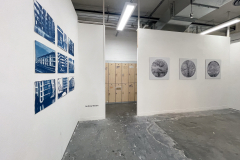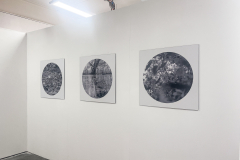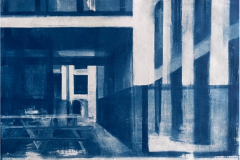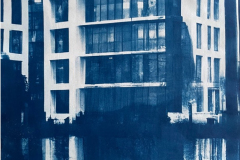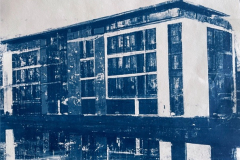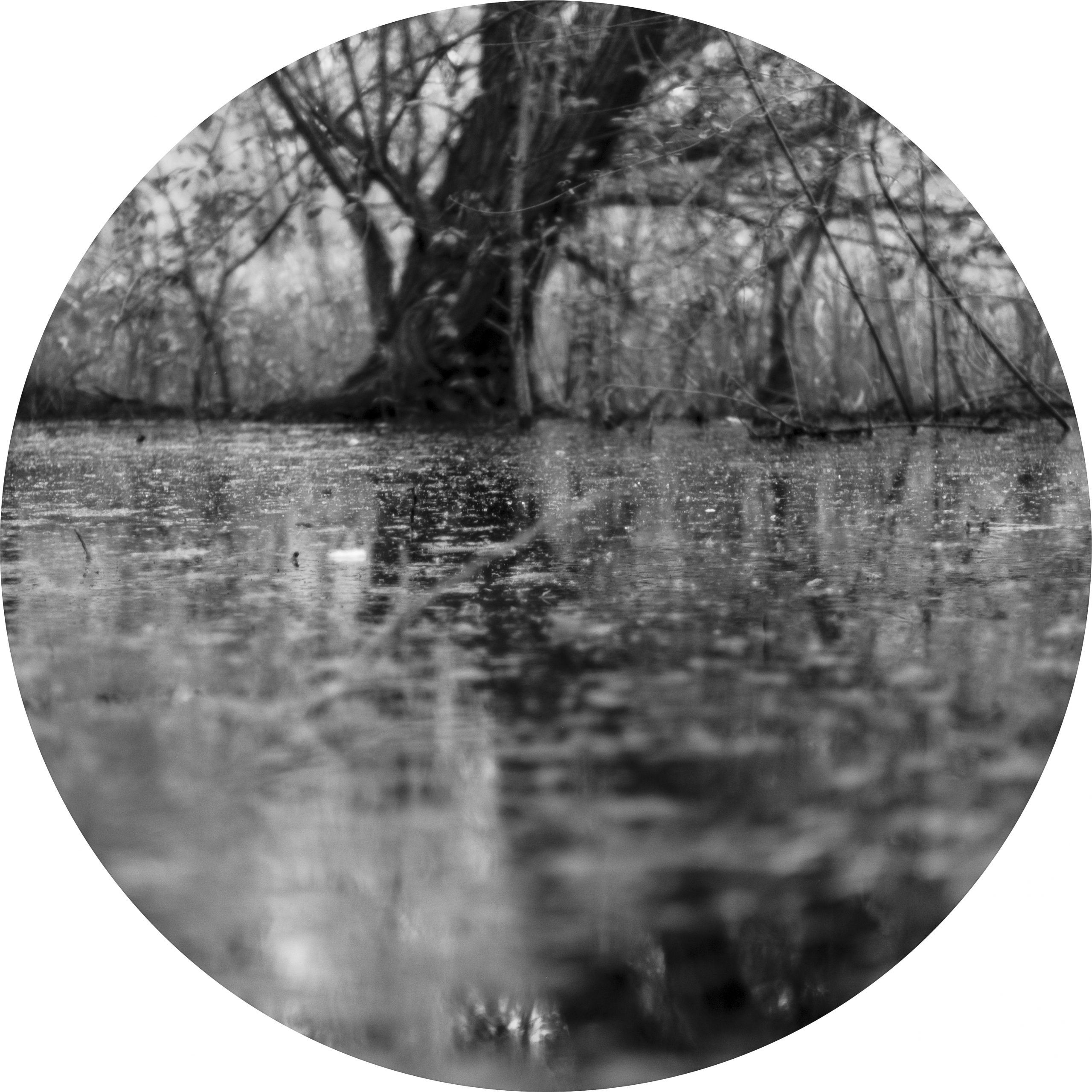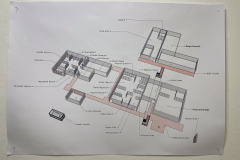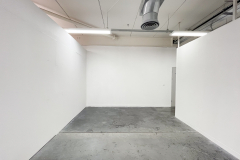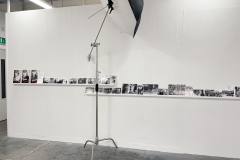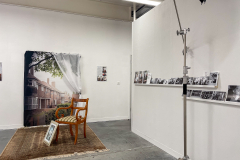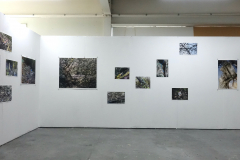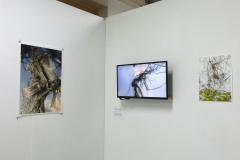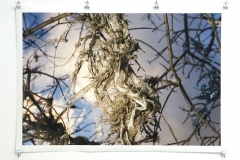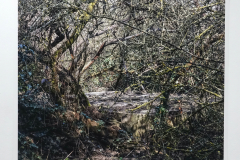DFA Showcase 2024
Permeability
The work. Spatial metaphors both help and hinder how we make sense of, and make our way in, the world. Adoption of the territorial notion of the boundary helps us to think about relationships between people, places, things and the more than human, and to speculate about, for instance, the relative strength of our sense of separation/insulation and strategies for boundary crossing. It also sends us on the never-ending quest, or contest, to determine where one thing ends and another begins. Whilst we can think about the edgelands that line the urban stretches of our rivers in terms of bounded packages of land, variously owned and consigned to specific functions, from infrastructure to recreation, or left to their own devices, these are clearly leaky and permeable spaces. So much more than the river flows through them. The three projections and soundscapes (Beneath, River Roding/A406 and Black on Maroon) explore that permeability. Time periods tumble into and intermingle with each other, substances are mutually compromised and transformed, vibrations from sources out of sight agitate us and disturb the landscape, processes from the past recast the present. In the fourth piece, an installation comprising of primative camera obscura made from cardboard boxes, plastic lenses and tracing paper, bring the outside visually into the darkened room. Permeability abounds and boundaries lose their purchase.
Comment. In an earlier project, I walked around the edges of housing developments in east London making images and field recordings, which I combined with texts, maps, historical images and other material to create portable archives to use in activities with residents. I noted the differences between what can be seen and what can be heard in the process of urban regeneration (and what cannot be seen and heard, and said and thought, and the influence on this of how experiences are mediated and knowledge constructed). In planning an Arts Council bid this year, I walked with a collaborating artist along the urban sections of the River Roding, which runs alongside and beneath several major roads and motorways in east London. She remarked that the incessant thunderous sound of the roads ‘spoiled’ her experience of the river and surrounding landscape. At the end of a difficult year, I want to take the opportunity to extend my practice to explore the idea of ‘spoiling’ in relation to time and different modes of engagement with and experience of the environment.
Research. My practice-based research explores plurality in contemporary art, through the design and implementation of a series of collaborative multi-disciplinary projects and the dissemination and analysis of the artistic work produced. Artists commonly lead double or multiple lives, often as a response to economic precariousness. At a time of disruption and transformation of established practice provoked by a succession of global challenges, this study explores the creative potential of the ability to move between multiple and diverse contexts and forms of activity, and the benefits of the critical dialogues this facilitates.
Beneath, 2024
Black on Maroon, 2024
River Roding/A406 (without fade or soundtrack), 2024
Work in Progress Seminar, February 2024
Here is the presentation given at UEL on 8th February 2024. It contains two short videos, which I’ve posted separately below. I didn’t give a WIP presentation in the Autumn term this year – I took a break from the programme for six months, before and after my mother and father died in September. Reflections on the discussion and feedback received at the seminar to follow.
WIP Feb 2024 v2
DFA Showcase 2023
Terra Privata
The prevalence of private housing developments on previously industrial sites in east London has led to a proliferation of privately-owned public spaces (POPS). These include parks and other ‘green spaces’ that are freely open to the public, but subject to any conditions the owner wishes to impose, including possible restrictions on photography. My contribution to the DFA Showcase brings together work from three series to explore three privately owned public spaces in east London.
Blueprints for a Connected Community 1-9
Nine handprinted cyanotypes from digital negatives on Canson Mixed Media paper, 42 cm x 30 cm.
Images generated by DALL-E2, ‘an AI system that can create realistic images and art from a description in natural language’ (Open AI website, accessed 29.05.23)’ from in situ descriptions of three private housing developments in east London. Prints exposed in natural light, processed in water and dried in the air in various east London locations.
Mature Stage of Life, 2023
Three 70 cm x 70 cm UV cured pigment prints on dibond
There are no mature trees on the three developments. These infra-red photographs are of the nearest ancient or veteran tree to each place, identified using the Woodland Trust Ancient Tree Inventory. ‘Veteran trees are complex, support biodiversity, have cultural and heritage value and provide continuity in a changing world. They are usually in their second or mature stage of life and bear ‘the ‘scars’ of age such as decay in the trunk, branches or roots, fungal fruiting bodies, or dead wood’ (Ancient Tree Guide no.4: What is an ancient tree?, The Woodland Trust, 2008: 5).
A New Kind of London Living, 2023
Three 70 cm x 70 cm UV cured pigment prints on dibond
Late nineteenth century photographic emulsions are sensitive to just ultraviolet and blue, and unable to register chlorophyll, only perceptible in the near infra-red portion of the electromagnetic spectrum. This gives the landscape a muted and distant allure, producing images that supported the spurious colonial notion of ‘terra nullius’. Present day developers adopt a similar position, claiming to bring new value to spoiled places, for instance ‘restoring a sense of ecological balance to this once industrial site’. The images in this series are made at the edges of each of the three developments with a sensor that simulates nineteenth century emulsions.
Work in Progress Seminar, March 2023
Work in Progress Seminar, November 2022
DFA Showcase 2022
Please Show Your Working
Thames View Women – Platinum Jubilee (2022)
13 colour giclée prints, 33 cm x 48 cm
(Pam, Yolanda, Lilyana, Chris, Fatuma, Ruby, Claire, Brenda, Natalie, Carole, Tia, Josie, Susie).
3 colour giclée prints, 21 cm x 30 cm
(Anthony, Aaron, Bayley).
100 monochrome prints, various sizes.
Portable studio installation, mixed media.
Research Exploitation (2022)
Three sets of five monochrome prints, 21 cm x 30 cm, framed.
(Untitled #87, Rumpled #87, Ripped #87, Jumbled #87, Crumpled into a ball #87; Untitled #88, Rumpled #88, Ripped #88, Jumbled #88, Crumpled into a ball #88; Untitled #89, Rumpled #89, Ripped #89, Jumbled #89, Crumpled into a ball #89).
Waste-bin with thesis pages crumpled into balls and thesis cover.
A3 sheet with calculations and QR code link to animated gifs.
Work in Progress Seminar, March 2022
Work in Progress Seminar, November 2021
DFA 2021 showcase exhibition and feedback
Focusing on presentations, writing and getting on with producing new work left me relatively unprepared for the DFA Showcase exhibition. I decided to present work from two series from my River Roding residency: Habitation and Single-use. Both are still work in progress, so I hadn’t (and still haven’t) given any deep thought to how they might be presented in a gallery setting. I made an early commitment to mounting the work directly on the wall (using Wolfgang Tillmans style tape hinges for the prints up to A3+ size and bulldog clips for the larger prints), which relieved me from the pressure, and expense, of mounting and framing. I also took the opportunity to experiment with digital upscaling for the larger prints, and using different papers for the Single-use series (settling on a wonderful bamboo paper by Awagami). I also had to take into account the relatively short time available to install and take down the exhibition, and the (disappointing) fact that university covid measures restricted us to only three guests to view the exhibition (though is was good that DFA students could view and discuss each others work).
Alongside the Single-use prints, I installed a short animation with soundscape (running on a Raspberry Pi feeding a 32″ monitor with speakers). The animation showed the morphing of images of plastic bags entangled in trees along the Roding shot with flash and naturally backlit. The soundscape was a binaural field recording made at the site of the photographic work. The unifying theme of the work was the idea of ‘matter out of place’, though this was relatively weakly framed.
The experience of mounting the exhibition, and seeing work produced by others in the later stages of the programme, made it clear that I have to focus more on the production of work for the showcase in subsequent years. Gallery exhibition is not likely to become a major part of my practice, which will continue to focus more on placing the work in unconventional exhibition spaces and keeping public engagement with the work close to its site of production. On the final day of the exhibition, we received feedback from Lewis Paul (a film-maker based at Leeds Beckett University, and a graduate of the DFA programme). This was billed as a Guest Seminar, but was more akin to a critique in which we moved from one exhibition space to another and engaged with Lewis’s reflections on and questions about the work.
In his notes on my work, Lewis observed that whilst diverse methods of making are clearly central to my practice, I need to give greater thought to the staging of the work and how this relates to what I am attempting to communicate or invoke. He also raised the related issue of the relationship between evidence and aesthetics and, in particular how evidence can be transformed into the poetic (or rendered as poetic). His key point was to think more carefully about widening accessibility of the work and consideration of how the work is staged and accessed. Good points, I think, and important to consider in relation to my experience to date of presenting work in non-gallery spaces. He suggested looking again at Eisenstein montage theory (which harks back to my early channel mixing work and the influence of Moi Ver and Peter Kennard in the juxtaposition of images), and also to help think through the relationship between the soundscapes and the visual work (citing work by Chris Watson). In discussion, he also raised the issue of the titling of work as a way of provoking interest and engagement (citing the YBAs use of titles that intrigue). In his more general comments he positioned the contribution of DFA research in interesting ways, for instance the strategy of identifying research ‘cul de sacs’ that other forms of theory and disciplinary research have been unable to address, but which can be addressed, in practice, through our own artistic work. Most importantly, he reinforced the need, in a practice-based, professional doctorate, to demonstrate how my work makes a specific contribution.











